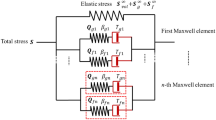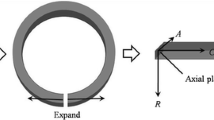Abstract
Knowledge of the mechanical properties of blood vessels and determining appropriate constitutive relations are essential in developing methodologies for accurate prognosis of vascular diseases. We examine the directional variation of the mechanical properties of the porcine thoracic aorta by performing uniaxial extension tests on dumbbell-shaped specimens cut at five different orientations with respect to the circumferential direction of the aorta. Specimens in all the orientations considered exhibit a nonlinear constitutive response that is typical of collagenous soft tissues. Shear strain under uniaxial extension demonstrates clearly discernible anisotropy of the mechanical response of the porcine aorta, and samples oriented at 45\(^{\circ }\) and 60\(^{\circ }\) with respect to the circumferential direction show a peculiar crescent-shaped shear strain-nominal stretch response not displayed by axial and circumferential specimens. Failure stress indicates decreasing tensile strength of the porcine aortic wall from the circumferential direction to the longitudinal direction. Furthermore, we determine the material parameters for the four-fiber-family and Gasser–Holzapfel–Ogden models from the mechanical response data of the circumferential and longitudinal specimens. It is shown how the material parameters derived from the uniaxial tests on circumferential and longitudinal specimens are insufficient to characterize the response of off-axis specimens.








Similar content being viewed by others
References
Atienza, J. M., G. V. Guinea, F. J. Rojo, R. J. Burgos, C. García-Montero, F. J. Goicolea, P. Aragoncillo, and M. Elices. The influence of pressure and temperature on the behavior of the human aorta and carotid arteries. Revista Española de Cardiología 60(3):259–267, 2007.
Baek, S., R. L. Gleason, K. Rajagopal, and J. Humphrey. Theory of small on large: potential utility in computations of fluid-solid interactions in arteries. Comput. Methods Appl. Mech. Eng. 196(31–32): 3070–3078, 2007.
Blaber, J., B. Adair, and A. Antoniou. Ncorr: open-source 2d digital image correlation matlab software. Exp. Mech. 55(6):1105–1122, 2015.
Chagnon, G., M. Rebouah, and D. Favier. Hyperelastic energy densities for soft biological tissues: a review. J. Elast. 120(2):129–160, 2015.
Chen, Q., Y. Wang, and Z.-Y. Li. Re-examination of the mechanical anisotropy of porcine thoracic aorta by uniaxial tensile tests. Biomed. Eng. 15(2):493–506, 2016.
Dobrin, P. B. Biaxial anisotropy of dog carotid artery: estimation of circumferential elastic modulus. J. Biomech. 19(5):351–358, 1986.
Duprey, A., O. Trabelsi, M. Vola, J.-P. Favre, and S. Avril. Biaxial rupture properties of ascending thoracic aortic aneurysms. Acta Biomater. 42:273–285, 2016.
Ferruzzi, J., D. A. Vorp, and J. Humphrey. On constitutive descriptors of the biaxial mechanical behaviour of human abdominal aorta and aneurysms. J. R. Soc. Interface 8(56):435–450, 2011.
García-Herrera, C. M., D. J. Celentano, M. A. Cruchaga, F. J. Rojo, J. M. Atienza, G. V. Guinea, and J. M. Goicolea. Mechanical characterisation of the human thoracic descending aorta: experiments and modelling. Comput. Methods Biomech. Biomed. Eng. 15(2):185–193, 2012.
Gasser, T. C., R. W. Ogden, and G. A. Holzapfel. Hyperelastic modelling of arterial layers with distributed collagen fibre orientations. J. R. Soc. Interface 3(6):15–35, 2006.
Gundiah, N., M. B. Ratcliffe, and L. A. Pruitt. The biomechanics of arterial elastin. J. Mech. Behav. Biomed. Mater. 2(3):288–296, 2009.
Hill, M. R., X. Duan, G. A. Gibson, S. Watkins, and A. M. Robertson. A theoretical and non-destructive experimental approach for direct inclusion of measured collagen orientation and recruitment into mechanical models of the artery wall. J. Biomech. 45(5):762–771, 2012.
Holzapfel, G. A., G. Sommer, C. T. Gasser, and P. Regitnig. Determination of layer-specific mechanical properties of human coronary arteries with nonatherosclerotic intimal thickening and related constitutive modeling. Am. J. Physiol.-Heart Circ. Physiol. 289(5):H2048–H2058, 2005.
Humphrey, J. Vascular adaptation and mechanical homeostasis at tissue, cellular, and sub-cellular levels. Cell Biochem. Biophys. 50(2):53–78, 2008.
Humphrey, J., and K. Rajagopal. A constrained mixture model for growth and remodeling of soft tissues. Math. Models Methods Appl. Sci. 12(03):407–430, 2002.
Iliopoulos, D. C., R. P. Deveja, E. P. Kritharis, D. Perrea, G. D. Sionis, K. Toutouzas, C. Stefanadis, and D. P. Sokolis. Regional and directional variations in the mechanical properties of ascending thoracic aortic aneurysms. Med. Eng. Phys. 31(1):1–9, 2009.
Jiang, M., R. L. Sridhar, A. B. Robbins, A. D. Freed, and M. R. Moreno. A versatile biaxial testing platform for soft tissues. J. Mech. Behav. Biomed. Mater. 114:104144, 2020.
Korenczuk, C. E., L. E. Votava, R. Y. Dhume, S. B. Kizilski, G. E. Brown, R. Narain, and V. H. Barocas. Isotropic failure criteria are not appropriate for anisotropic fibrous biological tissues. J. Biomech. Eng. 139:7, 2017.
Liu, M., H. Dong, X. Lou, G. Iannucci, E. P. Chen, B. G. Leshnower, and W. Sun. A novel anisotropic failure criterion with dispersed fiber orientations for aortic tissues. J. Biomech. Eng. 142:11, 2020.
Myneni, M., A. Rao, M. Jiang, M. R. Moreno, K. Rajagopal, and C. C. Benjamin. Segmental variations in the peel characteristics of the porcine thoracic aorta. Ann. Biomed. Eng. 48(6):1751–1767, 2020.
O’Leary, S. A., B. J. Doyle, and T. M. McGloughlin. The impact of long term freezing on the mechanical properties of porcine aortic tissue. J. Mech. Behav. Biomed. Mater. 37:165–173, 2014.
Patel, D. J., D. L. Fry, and J. S. Janicki. The elastic symmetry of arterial segments in dogs. Circ. Res. 24(1):1–8, 1969.
Peña, J. A., M. A. Martínez, and E. Peña. Layer-specific residual deformations and uniaxial and biaxial mechanical properties of thoracic porcine aorta. J. Mech. Behav. Biomed. Mater. 50:55–69, 2015.
Raghavan, M., and D. A. Vorp. Toward a biomechanical tool to evaluate rupture potential of abdominal aortic aneurysm: identification of a finite strain constitutive model and evaluation of its applicability. J. Biomech. 33(4):475–482, 2000.
Raghavan, M. L., M. W. Webster, and D. A. Vorp. Ex vivo biomechanical behavior of abdominal aortic aneurysm: assessment using a new mathematical model. Ann. Biomed. Eng. 24(5):573–582, 1996.
Rajagopal, K. Multiple configurations in continuum mechanics. Reports of the institute for computational and applied mechanics 6, 1995.
Rajagopal, K. R., and K. Rajagopal. Modeling of the aorta: complexities and inadequacies. AORTA J. 8(4):91, 2020.
Rajagopal, K. R., and A. R. Srinivasa. On the thermomechanics of materials that have multiple natural configurations part i: Viscoelasticity and classical plasticity. Zeitschrift für angewandte Mathematik und Physik ZAMP 55(5):861–893, 2004.
Roy, C. S. The elastic properties of the arterial wall. J. Physiol. 3(2):125–159, 1881.
Sang, C., S. Maiti, R. N. Fortunato, J. Kofler, and A. M. Robertson. A uniaxial testing approach for consistent failure in vascular tissues. J. Biomech. Eng. 140:6, 2018.
Sassani, S. G., Tsangaris, S., and Sokolis, D. P. Layer-and region-specific material characterization of ascending thoracic aortic aneurysms by microstructure-based models. J. Biomech. 48(14):3757–3765, 2015.
Schriefl, A. J., T. Schmidt, D. Balzani, G. Sommer, and G. A. Holzapfel. Selective enzymatic removal of elastin and collagen from human abdominal aortas: Uniaxial mechanical response and constitutive modeling. Acta Biomater. 17:125–136, 2015.
Schroeder, F., S. Polzer, M. Slažanský, V. Man, and P. Skácel. Predictive capabilities of various constitutive models for arterial tissue. J. Mech. Behav. Biomed. Mater. 78:369–380, 2018.
Sherifova, S., and G. A. Holzapfel. Biomechanics of aortic wall failure with a focus on dissection and aneurysm: a review. Acta Biomater. 99:1–17, 2019.
Sherifova, S., G. Sommer, C. Viertler, P. Regitnig, T. Caranasos, M. A. Smith, B. E. Griffith, R. W. Ogden, and G. A. Holzapfel. Failure properties and microstructure of healthy and aneurysmatic human thoracic aortas subjected to uniaxial extension with a focus on the media. Acta Biomater. 99:443–456, 2019.
Vaishnav, R. N., J. Vossoughi, D. J. Patel, L. N. Cothran, B. R. Coleman, and E. L. Ison-Franklin. Effect of hypertension on elasticity and geometry of aortic tissue from dogs. J. Biomech. Eng. 112(5):70–74, 1990.
Vorp, D. A., B. J. Schiro, M. P. Ehrlich, T. S. Juvonen, M. A. Ergin, and B. P. Griffith. Effect of aneurysm on the tensile strength and biomechanical behavior of the ascending thoracic aorta. Ann. Thorac. Surg. 75(4):1210–1214, 2003.
Wang, Y., J. Hahn, and Y. Zhang. Mechanical properties of arterial elastin with water loss. J. Biomech. Eng. 140:4, 2018.
Weisbecker, H., D. M. Pierce, P. Regitnig, and G. A. Holzapfel. Layer-specific damage experiments and modeling of human thoracic and abdominal aortas with non-atherosclerotic intimal thickening. J. Mech. Behav. Biomed. Mater. 12:93–106, 2012.
Weizsäcker, H. W., and T. D. Kampp. Passive elastic properties of the rat aorta. Biomed. Eng. 35(10):224–234, 1990.
Weizsacker, H. W., and J. G. Pinto. Isotropy and anisotropy of the arterial wall. J. Biomech. 21(6):477–487, 1988.
Zou, Y., and Y. Zhang. An experimental and theoretical study on the anisotropy of elastin network. Ann. Biomed. Eng. 37(8):1572–1583, 2009.
Acknowledgments
We would like to thank Dr. Michael Moreno for providing the lab facilities to conduct the experiments. This research was funded by Texas A&M Engineering Experiment Section.
Conflict of Interest
All authors declare that they have no conflicts of interest.
Author information
Authors and Affiliations
Corresponding author
Additional information
Associate Editor Jane Grande-Allen oversaw the review of this article.
Publisher's Note
Springer Nature remains neutral with regard to jurisdictional claims in published maps and institutional affiliations.
Supplementary Information
Below is the link to the electronic supplementary material.
Rights and permissions
About this article
Cite this article
Myneni, M., Sridhar, R.L., Rajagopal, K.R. et al. Experimental Investigation of the Anisotropic Mechanical Response of the Porcine Thoracic Aorta. Ann Biomed Eng 50, 452–466 (2022). https://doi.org/10.1007/s10439-022-02931-2
Received:
Accepted:
Published:
Issue Date:
DOI: https://doi.org/10.1007/s10439-022-02931-2




